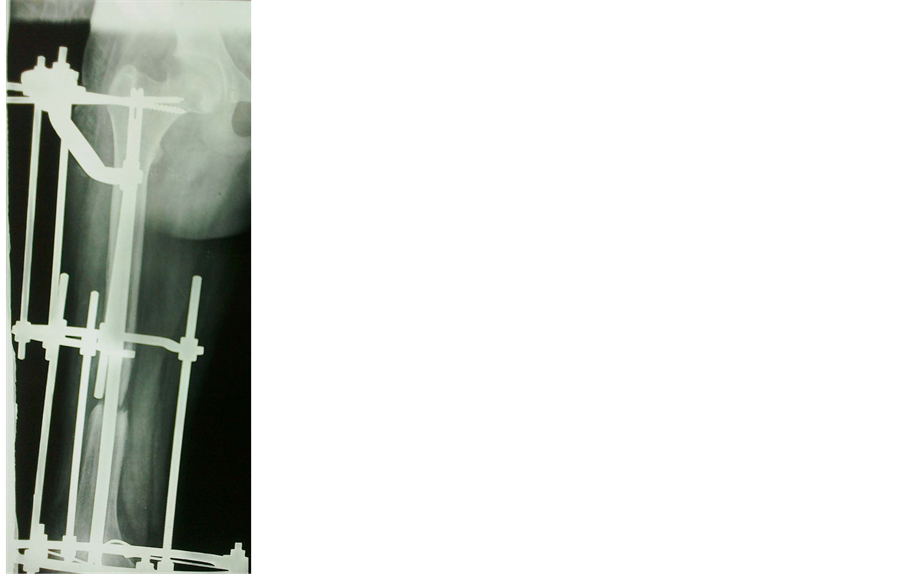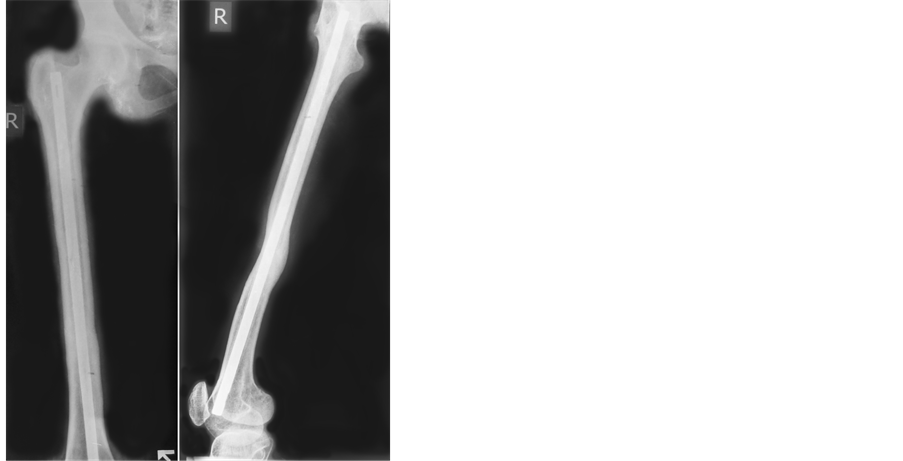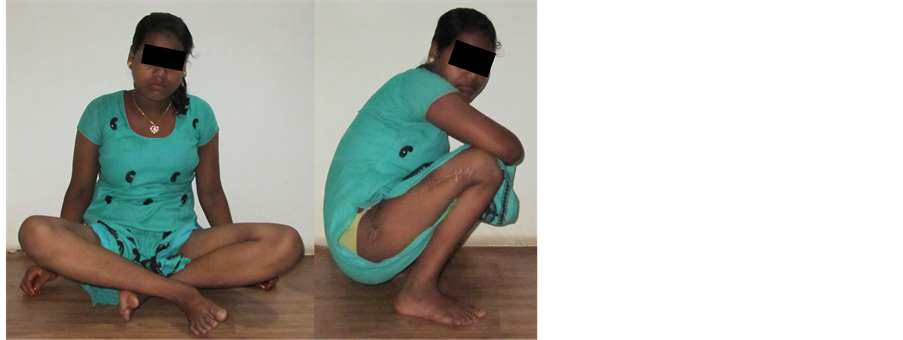Open Journal of Orthopedics
Vol.4 No.7(2014), Article
ID:48221,6
pages
DOI:10.4236/ojo.2014.47030
Accordion Manoeuvre with Ilizarov Frame over Nail in Situ in a Case of Infected Non-Union of Femur: Discussion on Strategies: A Case Report
Ranjit Kr. Baruah
Department of Orthopaedics, Assam Medical College, Dibrugarh, India
Email: dr_ranjit53@rediffmail.com
Copyright © 2014 by author and Scientific Research Publishing Inc.
This work is licensed under the Creative Commons Attribution International License (CC BY).
http://creativecommons.org/licenses/by/4.0/



Received 20 May 2014; revised 5 July 2014; accepted 19 July 2014
ABSTRACT
Quiescent Type of H. Rosen & Stage 2 of C.L. Romano et al. for Infected Non Union of Femur after K-nailing (Küntscher nailing) require no debridement & removal of nail and therefore can be treated by a single stage procedure. There are a few reports of treating aseptic non-union of femur by compression alone or compression distraction over nail by Ilizarov Technique. However, no case of Infected Non-Union femur being treated by Accordion Manoeuvre with Ilizarov over nail in situ (i.e. without exchange nailing) has been reported so far. Here, we are reporting a case of Infected Non-Union following K-nailing for a fracture shaft of femur in a 15-year-old female, who was treated by this technique as a single stage procedure. An Ilizarov frame was mounted on the femur with nail in situ followed by Accordion Manoeuvre. The fracture was healed in 5.6 months with two cycles of Accordion Manoeuvre followed by rhythmic compression. There was no recurrence of infection.
Keywords:Infected Non-Union Femur, Accordion Manoeuvre by Ilizarov over Nail in Situ

1. Introduction
The suggested treatment for Quiescent Type of Infected Non Union is a single stage procedure with minimal or no debridement [1] [2] . The fate of the implant in Infected Non-Union is dependent on the stability it provides. If the nail still continues to provide stability it may be retained [3] . The technique of compression alone over nail by external fixator for non-union femur has been reported by a few authors only in aseptic non-union [4] [5] . Cyclic distraction and compression was used in another series to achieve union in non-union femur [6] . However, we have not been able to find any publication indicating treatment of Quiescent Type of Infected NonUnion of femur with nail in situ by Ilizarov frame and with Accordion Manoeuvre.
We are reporting such a case, of a 15-year-old female who developed Infected Non-Union following K-nailing (Küntscher nailing) done for a fracture shaft of femur, whom we treated by Accordion Manoeuvre through Ilizarov frame, mounted with nail in situ (i.e. without exchange nailing). In this paper, we are discussing the strategies that were used for bringing about a satisfactory outcome in the case.
2. Case Report
A 15-year-old female sustained fracture at the junction of the middle and lower third of shaft of the right femur following a road traffic accident. She was treated by Open Reduction and Internal Fixation with a K-nail (Küntscher nail) elsewhere. Upon query, she reported a history of pain and swelling at the operation site after about 8 weeks of operation followed by rupture of the operating wound that started draining pus. The condition was treated by the original surgeon with debridement and antibiotics that were continued for a period of 6 weeks. Eventually, the wound healed. However, she was referred to us, (after about 8 months of the first surgery), as she was unable to bear her entire weight on the affected limb, and also had a sense of instability in the concerned limb. During examination, we found minimum tenderness without any abnormal mobility at the fracture site; there were no signs of local infection and there was no drainage for past 4 months, as reported by the patient. Range of Motion (ROM) at the knee joint was 150-150-600 with normal hip motions. Her X-Ray showed gap at fracture site without any evidence of callus and sequestrum (Figure 1).
A working diagnosis of Quiescent Type [1] and Stage 2 [3] Infected Non-Union was made to tailor the treatment.
A thorough evaluation of the patient was done. The nail did not appear to be snugly fitted into the medullary cavity in the X-ray and we expected that the fragments could be moved on it during compression and distraction. An Ilizarov frame was mounted, with the nail in situ. The apparatus consisted of an arch in the proximal segment at the level of greater trochanter, and a full frame near the knee joint with a free stabilising ring in between. 4.5 mm Schanz screws were used in the arch while olive wires were used in the distal fragment (Figure 2). Accordion Manoeuvre (AM) was started once the pain of insertion of the pin and wire faded out.
Accordion Manoeuvre (AM) consisted of compression (at the rate of 0.25 mm) twice daily for 7 days, followed by distraction at a similar rate and rhythm for another 7 days followed by rest for 3 days. This consisted

Figure 1. Pre operative X-ray of patient.

Figure 2. Mounting of Ilizarov apparatus with nail in situ.
of a cycle of AM. Two such cycles were performed, followed by compression at the fracture site at the rate of 0.25 mm every alternate day, till appreciable healing could be seen in the X-ray. Parents of the patient were instructed about the procedure of pin-site care. A regular follow-up (after every 4-weeks interval) was done till the fracture united. After complete healing of the fracture, as evidenced in the X-ray, the apparatus was removed after five and half months from the date of application. She was instructed to undergo physiotherapy to regain range of movement at the knee joint. At the last follow up, the fracture re-modelled well (Figure 3) and the patient regained full ROM at Knee joint (Figure 4). No deep-seated infection was seen in the case.
2. Discussion
The incidence of infection following intramedullary nailing (IM nailing) in closed long bone fractures is approximately 1% - 2% [7] . This incidence is considerably higher in open fractures [8] -[10] .
We are yet to come across any report showing Accordion Manoeuvre with Ilizarov with nail in situ (i.e. with out exchange nailing) in femoral Quiescent Type of Infected Non-Union; and hence, there is every possibility that ours is the only report in this aspect.
Accordion Manoeuvre is “Bloodless stimulation” of bone healing as described by Professor Ilizarov. It comprises of alternate compression and distraction at the fracture site that converts the scar tissue at the fracture site into tissues capable of neo-genesis. Compression brings the fragments into contact and crushes the scar tissue between them. Distraction creates columnar fibro-vascular tissues that arise from the crushed scar tissue on the fracture surface. Repeated distraction stimulates the production of osteoblast and helps the collagen bundles consolidate within a bony matrix. Generally, the suggested protocol for this manoeuvre is compression for 10 days, followed by distraction up to 10 - 20 mm, at the rate of 0.25 mm twice a day, which is followed by rest for 7 - 10 days; and then slow compression again up to 7 - 10 mm. After a rest period for 5 - 7 days, distraction is performed for second time [11] . Although it was indicated in Hypertrophic or Normotrophic non-union, Ilizarov himself used AM in mobile non-unions also and the resultant healing was termed as Transformational osteogenesis [12] . It is now an established fact that controlled process of distraction helps in creation of mechanobiological conditions (tissue strain) that stimulate new bone formation mostly by intra-membranous ossification [13] . In an experimental study, Lutz Claes concluded that temporary cyclic distraction and compression can en-

Figure 3. Healed fracture with re-modelling.

Figure 4. Full functions at hip & knee joints after surgery.
hance better bone healing by producing early increased bone volume that has higher bending rigidity [14] .
H. Rosen’s [1] classification of Infected Non-Union describes the status of pathology at the site of infection (Table 1). It helps to decide the treatment strategies.
We classified our case to be a Quiescent Type of Infected Non-Union as there was no discharge from the local site for more than3 months besides the fact that there was no evidence of sequestrum.
Romano CL et al. [3] classified Post Implant Infections into three stages depending upon duration, status of stability provided by the implant and presence or absence of deep seated bony infection (Table 2).
We labeled our case at Stage 2 of Romano CL et al. as the infection started within 8 weeks of initial surgery and local infection had not spread to whole of the shaft. The nail implanted earlier appeared to provide stability and therefore its removal was not considered.
The aim of treating the case was to achieve healing of the fracture without reactivation of infection. A lesstraumatic and minimally invasive procedure would be the best choice of treatment in such situation. Since there was no evidence of active infection, both clinical and radiological, we proposed to mount the Ilizarov frame with nail in situ. The nail did not appear to be snugly fitted into the medullary cavity in the X-ray and we expected that the fragments could be moved on it during compression and distraction. Cyclic Distraction and compression (AM) would stimulate healing and final rhythmical compression would lead to consolidation. Altogether it would
Table 2. Romano CL et al. classification of post-implant infections.
be a less traumatic endeavour. There would be only one operation without the need for another surgical intervention like corticotomy, bone grafting etc.
Considering the young age of the patient and a belief in the capability of new tissue formation under adequate stimulation at this age, it was decided to modify the rate of Accordion Manoeuvre by reducing the number of days of the cycle. Infection did not recur in this case. The case confirmed the acceptability of both H. Rosen’s & Ramano CL et al.’s classification of Infected Non-Union with suggested treatment protocol.
3. Conclusion
H. Rosen’s Quiescent Type & C.L. Romano’s Stage 2 Infected Non-Union after IM nailing in femur require no debridement & removal of the nail. In the absence of active infection, an Ilizarov frame can be mounted in such case with nail in situ safely. Accordion Manoeuvre with subsequent compression ensures union & consolidation in such situation. Our case merits to be considered as the only case report in this type of difficult non-union.
References
- Rosen H. (1998) Nonunion and Malunion. In: Browner, B.D., Levine, A.M. and Jupitar, J.B., Eds., Skeletal Trauma: Fractures, Dislocations, Ligamentous Injuries, WB Saunders, Philadelphia, 501-541.
- Muller, M.E., et al. (1990) Manual of Internal Fixation. 3rd Edition, Springer-Verlag, 714, 722-723.
- Romano, C.L., Romano, D., Logoluso, N. and Drago, L. (2011) Bone and Joint Infections in Adults: A Comprehensive Classification Proposal. European Orthopaedics and Traumatology, 1, 207-217. http://dx.doi.org/10.1007/s12570-011-0056-8
- Brinker, M.R. and O’Connor, D.P. (2003) Ilizarov Compression over a Nail for Aseptic Femoral Nonunions That Have Failed Exchange Nailing: A Report of Five Cases. Journal of Orthopaedic Trauma, 17, 668-676. http://dx.doi.org/10.1097/00005131-200311000-00002
- Menon, D.K., Dougall, T.W., Pool, R.D., et al. (2002) Augmentative Ilizarov External Fixation after Failure of Diaphyseal Union with Intramedullary Nailing. Journal of Orthopaedic Trauma, 16, 491-497. http://dx.doi.org/10.1097/00005131-200208000-00007
- Inan, M., Karaoglu, S., Cilli, F., Turk, C.Y. and Harma, A. (2005) Treatment of Femoral Nonunions by Using Cyclic Compression and Distraction. Clinical Orthopaedics and Related Research, No. 436, 222-228. http://dx.doi.org/10.1097/01.blo.0000159153.09508.97
- Duan, X., Al-Qwbani, M., Zeng, Y., Zhang, W. and Xiang, Z. (2012) Intramedullary Nailing for Tibial Shaft Fractures in Adults. Cochrane Database of Systematic Reviews, 1, Article ID: CD008241. http://dx.doi.org/10.1002/14651858.CD008241.pub2
- Henley, M.B., Chapman, J.R., Agel, J., Harvey, E.J., Whorton, A.M. and Swiontkowski, M.F. (1998) Treatment of Type II, IIIA, and IIIB Open Fractures of the Tibial Shaft: A Prospective Comparison of Unreamed Interlocking Intramedullary Nails and Half-Pin External Fixators. Journal of Orthopaedic Trauma, 12, 1-7. http://dx.doi.org/10.1097/00005131-199801000-00001
- Guo, J.J., Tang, N., Yang, H.L. and Tang, T.S. (2010) A Prospective, Randomised Trial Comparing Closed Intramedullary Nailing with Percutaneous Plating in the Treatment of Distal Metaphyseal Fractures of the Tibia. Journal of Bone and Joint Surgery (British), 92, 984-988. http://dx.doi.org/10.1302/0301-620X.92B7.22959
- Littenberg, B., Weinstein, L.P., McCarren, M., et al. (1998) Closed Fractures of the Tibial Shaft. A Meta-Analysis of Three Methods of Treatment. Journal of Bone and Joint Surgery, 80, 174-183.
- Golyakhovsky, V. and Frankel, V. (1993) Operative Manual of Ilizarov Techniques. Mosby Yearbook, Inc., Saint Louis, 146-148.
- Goldstein, R.Y., et al. (2013) The Evolution of the Ilizarov Technique Part 2: The Principles of Distraction Osteosynthesis. Bulletin of the Hospital for Joint Diseases, 71, 96-103.
- Ilizarov, G.A. (1989) The tension-stress effect on the genesis and growth of tissues. Part I. The influence of stability of fixation and soft-tissue preservation. Clinical Orthopaedics and Related Research, 238, 249-281.
- Claes, L., Augat, P., Schorlemmer, S., Konrads, C., Ignatius, A. and Ehrnthaller, C. (2008) Temporary Distraction and Compression of a Diaphyseal Osteotomy Accelerates Bone Healing. Journal of Orthopaedic Research, 26, 772-775. http://dx.doi.org/10.1002/jor.20588


